The history of the WWII German NSKK Dagger -
The National Socialist Motor Corps (German: Nationalsozialistisches Kraftfahrkorps, NSKK), also known as the National Socialist Drivers Corps, was a paramilitary organization of the Nazi Party that existed from 1931 to 1945. The group was a successor organization to the older National Socialist Automobile Corps, which had existed since the beginning of 1930. It was headed by Adolf Hühnlein from 1934. After Hühnlein's death in 1942 Erwin Krauss took over his position as Korpsführer (Corpleader).
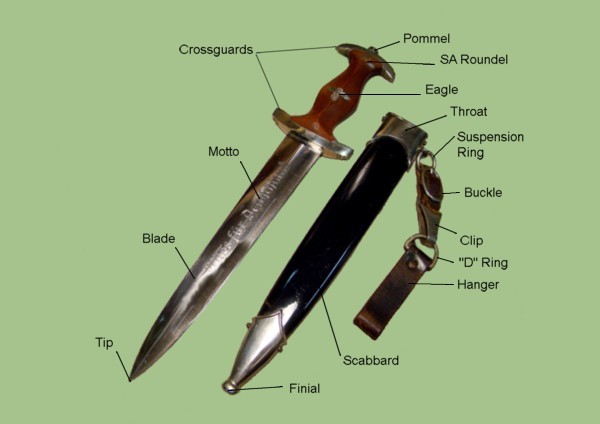
The National Socialist Motor Corps was the smallest of the Nazi Party organizations and had originally been formed as a motorized corps of the Sturmabteilung (SA). In 1934, the group had a membership of approximately ten thousand and was separated from the SA to become an independent organization. This action may have saved the NSKK from extinction, as shortly thereafter the SA suffered a major purge during the Night of the Long Knives.
1933 PATTERN NSKK DAGGER
The German NSKK dagger was instituted in 1933. The dagger was
produced until 1945. No less than 455,000 of these daggers were produced during that time. It was issued to the front line
NSKK personnel. The highest NSKK dagger was the 1938 Fuhrer model

The blade of the NSKK dagger consists of a double edge, stileto style. The motto "Alles fur Deutchsland",
which translated to "All for the Fatherland", was found on one side. The other side was blank.

The primary aim of the NSKK was to educate its members in motoring skills. They were mainly trained in the operation and maintenance of high performance motorcycles and automobiles. In the mid 1930s, the NSKK also served as a roadside assistance group, comparable to the modern-day American Automobile Association or the British Automobile Association
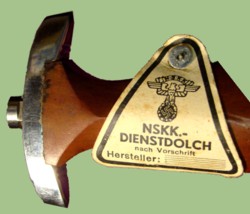 |
The daggers were issued with a paper bag and a tag wrapped around the handle. The tag was of triangular shape with
a metal rivet keeping the sides closed. The perimeter of the tag is outlined with a black line. The center shows the
NSKK eagle with the phrase "NSKK - Dienstdolch".
The paper bag is in the shape of a triangle. It is of light brown color. Black block letters spell out "NSKK Dolch".
The example shown here displays the RZM logo just below the letters. Note that not all of the bags displayed the
RZM symbol.
The SA and SS daggers were also issued with a triangular tag and a paper bag. It is important to notice that not all
daggers were issued with the characteristics shown here. in some instances only the bag was present. In other cases
neither the bag nor the handle tag were issued.
|
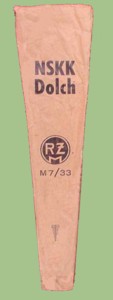 |
The design of the dagger consisted of a small, cylindrical pommel. Upper and lower crossguards that were made of
copper or tombak. A wooden handle in the shape of a Coke bottle. An SA eagle is inserted on one side of the handle
at about midpoint. An SA circular device is inserted above the eagle. The pommel holds the dagger together.
Unscrewing this part breaks apart the components.
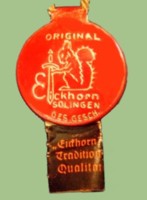 |
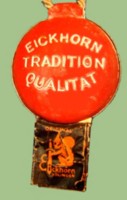 |
Certain manufacturer's issued The daggers with metal and paper tags. The photos to the left illustrate
the front and the back of the tags. The example featured here was issued by Eickhorn between the years
of 1935 and 1941. After 1941 the war effort was demanding as much metal as possible so the use of items
like these became less pervasive.
The design of the tag consists of a two piece circular structure sandwiched together. Made of tin. The Eickhorn
logo was palced in the front with the words "Original, Eickhorn, Solingen, Ges Gesch". The back section has the
words "Eickhorn, Tradition, Qualitat". The upper section creates a hollowed area where a string loop is placed.
This is how the tag was hung from the dagger. A paper tag is attached to the bottom.
|
MARINE NSKK DAGGER
The Marine NSKK was a smaller sub-division of the regular NSKK. It was decided that this organization should
have its own dagger. However, the command did not want to commit the resources to design a brand new dagger.
Instead, the regular NSKK dagger was lightly modified to indicate it belonged to the marine side of the NSKK.

The scabbard was available in the basic model as well as the chained version. In either case all fittings were
finished in either copper or tombak.
The chained version of the dagger was known as the model 1936. one distinguishing characteristic of this model was
the addition of a middle segment. The chain was attached to the upper and middle fittings. in some cases the
upper chain has three links instead of four. The example shown here has four links.
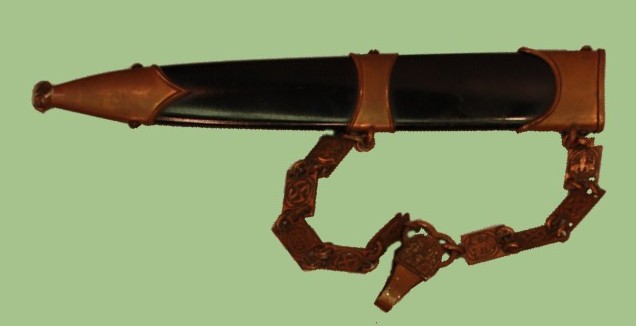
The blade of the Marine NSKK dagger is identical to all other NSKK daggers. Of double edge construction. The
motto "Alles Fur Deutchsland" is displayed in the center section of one side. The other side of the blade
shows the manufacturer's logo or RZM number.
MODEL 1936 NSKK DAGGER
The Model 1936 NSKK dagger was a direct response to the
introduction of the chained SS dagger. The decision to create the chained NSKK dagger rested on the hands of
Adolf Huhnlein.
The design of the 1936 dagger was based on the 1933 pattern. The main differences included the addition of a
suspension chain and the inclusion of a mid-point brace on the scabbard to accomodate the lower section of the
chain. The rest of the components of the dagger were identical to the 1933 model.
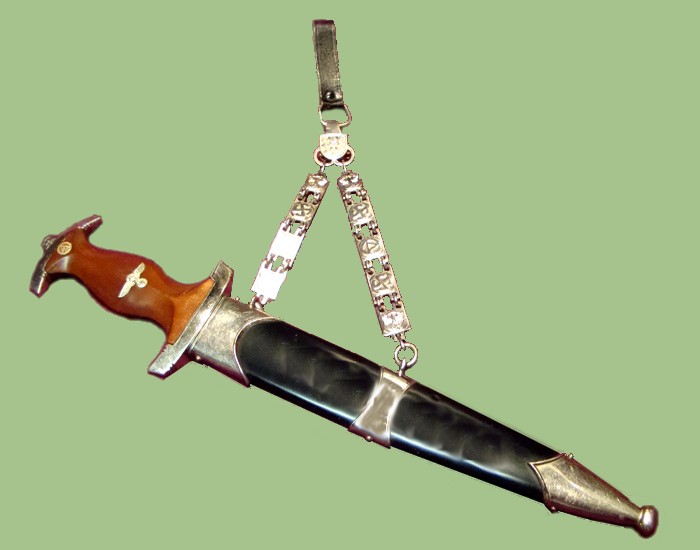
The design of the suspension chain consisted of square segments attached to each other with locking rings. The
upper chain had four segments while the lower chain contained five. Each section of chain was decorated with a
sunwheel swastika and eagle image. Both sections of chain were attached to the scabbard via suspension rings.
The 1936 NSKK dagger will be encountered with two different types of fittings. The early models were made of
nickel silver while the newer models consisted of nickel plating over base metal.
The blade of the 1936 NSKK model was identical to the regular NSKK dagger. Of double edge construction. One side
displayed the motto "Alles fur Deutchsland", which translates to "All for the Fatherland". The other side showed
the manufacturer's logo or RZM number near the base of the blade.
NSKK ROHM DAGGER
The Rohm dagger was created in order to recorgnize Ernst Rohm's great contributions to the SA. The dagger was identical to
the regular SA dagger except that it had the inscription "In Herzlicher Freundschaft Ernst Rohm", which translated to
"In heartfelt comradeship, Ernst Rohm", on the reverse of the blade. This dagger was authorized on December 1931 and
became known as the "Rohm" dagger. Since the NSKK derived from the SA the use of the Rohm dagger was carried over to
the NSKK.
Over the years Rohm's political views started to divert too far apart from Hitler's views. As a result, Hitler charged
Rohm with treason and ordered his execution (The night of the Long Knives - 1934). After this action took place it was
ordered that all Rohm daggers be eliminated from circulation. This was achieved in one of two ways; The dagger could
be destroyed or the special inscription could be taken off via grinder.

The blade of the NSKK Rohm dagger was identical to the regular NSKK dagger. Of double edge construction. One side
displayed the motto "Alles fur Deutchsland", which translates to "All for the Fatherland". The other side had the
motto "In Herzlicher Freundschaft Ernst Rohm", which translated to "In heartfelt comradeship, Ernst Rohm".
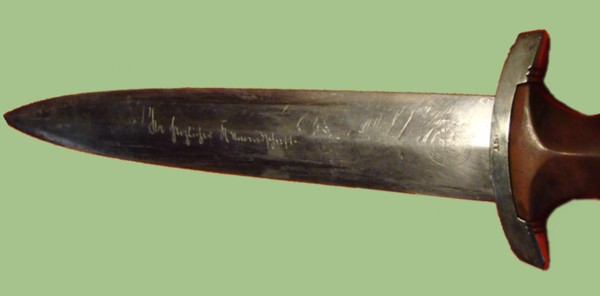
The Rohm dagger can be found in three primary states. With the Rohm inscription intact, this is the hardest to find. With the Rohm name removed from the inscription (photo shown above). With the inscription completly removed, sometimes even removing the manufacturer's logo. In some cases you can still make out some of the inscription at the end or the edges when found in this last state.
The following is a list of some of the companies that manufactured the NSKK daggers during WWII.
| Count |
Number |
Company |
Description |
Logo |
Comments |
| 1 |
1 |
Adlerblick |
|
n/a |
n/a |
| 2 |
2 |
Aesculap |
Snake around Staff in oval. Name and city inside doube oval. |
 |
Tutlingen |
| 3 |
3 |
AMSO Albert Melbus |
"AMSO"in circle |
n/a |
n/a |
| 4 |
4 |
Anvil |
|
n/A |
n/a |
| 5 |
5 |
Arrow |
|
n/a |
n/a |
| 6 |
6 |
Asso |
Crossed hobby horses |
 |
Another variation ofthis logo exsist but may have never been stamped on SA daggers. - Solingen |
| 7 |
7 |
Solinger Axt und |
Horse head inside double circle. Name and city surrounding. |
 |
HauerFabrik |
| 8 |
8 |
Backhaus |
Baby riding stork. Name on top. City on bottom. |
 |
Solingen |
| 9 |
9 |
Rich & S, Balke |
"BR&S"forming a cross, inside circle. name on top. City in bottom. |
 |
Solingen |
| 10 |
10 |
Fritz Barthelmess |
"Barvaria" in double oval. name on top. City in bottom. |
 |
Muggendorf |
| 11 |
11 |
Eduard, Becker (Kolumbuskwerk) Solingen |
Baker in star above name |
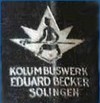 |
Solingen |
| 12 |
12 |
Gebruder, Becker Solingen |
Chef over name |
 |
Solingen |
| 13 |
13 |
Gebr Bell |
"GB" intertwined inside double oval. |
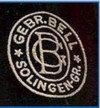 |
Solingen-GR |
| 14 |
14 |
Carl Bender |
TWo pitchers over name |
 |
Solingen |
| 15 |
15 |
Gebr. Berns |
Otter in oval |
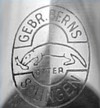 |
Solingen |
| 16 |
16 |
C Bertram & Sohn Reinhard Solingen |
Rooster and Hen over inside double oval. Name on top. |
 |
Solingen |
| 17 |
17 |
August Bickel |
"AB" at the top of a diamond with name and city inside. |
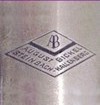 |
Steinbech-Hallenberg |
| 18 |
18 |
August Muller KG (Bismarch) Solingen |
Name in box |
n/a |
n/a |
| 19 |
19 |
Karl, Bocker |
Ostrich in oval |
n/a |
n/a |
| 20 |
20 |
Bodenstein |
Name around empty oval |
n/a |
n/a |
| 21 |
21 |
Bohmenachel |
|
n/a |
n/a |
| 22 |
22 |
H, Boker |
Tree over name |
n/a |
n/a |
| 23 |
23 |
E,Bonsmann |
Three anchors on shield |
n/a |
n/a |
| 24 |
24 |
Bontgen & Sabin |
Foot and football |
n/a |
n/a |
| 25 |
25 |
Geb, Born |
"GB"in oval |
n/a |
n/a |
| 26 |
26 |
Bruckmann |
Bridge in oval |
n/a |
n/a |
| 27 |
27 |
Rudolf, Buchel |
"RBS" in 8 pointed star in oval |
n/a |
n/a |
| 28 |
28 |
Bulldog |
Bulldog head only |
n/a |
n/a |
| 29 |
29 |
Ernst, Busch |
Name arched over solingen |
n/a |
n/a |
| 30 |
30 |
Christianswerk |
Fork inside oval |
n/a |
n/a |
A list with additional manufacturers is available.
This information is brought to you courtesy of MilitaryItems.com. The premiere provider of military
collectibles to musuems, educational institutions and the general enthusiast.
|







